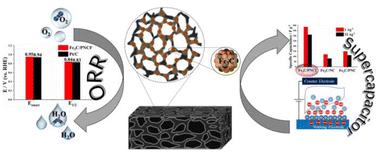Our official English website, www.x-mol.net, welcomes your feedback! (Note: you will need to create a separate account there.)
Iron carbide nanoparticles supported on an N-doped carbon porous framework as a bifunctional material for electrocatalytic oxygen reduction and supercapacitors
Nanoscale ( IF 6.7 ) Pub Date : 2022-11-23 , DOI: 10.1039/d2nr05620h Zengyu Han 1 , Wenfang Cai 2 , Shifeng Zhao 3 , Yi Zhao 3 , Jirui Bai 1 , Qingyun Chen 3 , Yunhai Wang 1
Nanoscale ( IF 6.7 ) Pub Date : 2022-11-23 , DOI: 10.1039/d2nr05620h Zengyu Han 1 , Wenfang Cai 2 , Shifeng Zhao 3 , Yi Zhao 3 , Jirui Bai 1 , Qingyun Chen 3 , Yunhai Wang 1
Affiliation

|
Highly active and durable bifunctional materials are of pivotal importance for energy conversion and storage devices, yet a comprehensive understanding of their geometric and electronic influence on electrochemical activity is urgently needed. Fe–N–C materials with physical and chemical structural merits are considered as one of the promising candidates for efficient oxygen reduction reaction electrocatalysts and supercapacitor electrodes. Herein, Fe3C nanoparticles supported on a porous N-doped carbon framework (denoted as Fe3C/PNCF) were readily prepared by one-step chemical vapor deposition under the assistance of a NaCl salt template. The experiment results revealed that the as-synthesized Fe3C/PNCF nanocomposites successfully displayed attractive electrocatalytic oxygen reduction reaction (ORR) activity comparable to that of the Pt/C catalyst (E1/2 of 0.84 V and 0.83 V, respectively), and a superior capacitance of 385.3 F g−1 under 1 A g−1 for a supercapacitor. It's proposed that the increased pyridinic and graphitic N coordination on the hydrophilic porous framework provides more electrochemical active surface area for the storage and transport of electrolyte ions. Additionally, an appropriate d-band center created by the optimized adsorption function endows Fe3C/PNCF with excellent electrochemical properties. The results confirmed that the integration strategy of porous heterogeneous structure and accessible active sites balanced the complex relationship between geometry, electronic structure, and electrochemical activity. Our research provides a facile approach for fabricating multi-functional nanomaterials applicable in both ORR and supercapacitors in the future.
中文翻译:

负载在 N 掺杂碳多孔框架上的碳化铁纳米颗粒作为电催化氧还原和超级电容器的双功能材料
高活性和耐用的双功能材料对于能量转换和存储设备至关重要,但迫切需要全面了解它们的几何和电子对电化学活性的影响。具有物理和化学结构优点的 Fe-N-C 材料被认为是高效氧还原反应电催化剂和超级电容器电极的有希望的候选材料之一。在此,在 NaCl 盐模板的帮助下,通过一步化学气相沉积很容易地制备了负载在多孔 N 掺杂碳骨架上的Fe 3 C 纳米颗粒(表示为 Fe 3 C/PNCF)。实验结果表明,所合成的 Fe 3C/PNCF 纳米复合材料成功地展示了与 Pt/C 催化剂相当的电催化氧还原反应 (ORR) 活性(E 1/2分别为 0.84 V 和 0.83 V),以及 385.3 F g -1的优异电容。 1 A g −1对于超级电容器。有人提出,亲水性多孔骨架上增加的吡啶和石墨 N 配位为电解质离子的存储和传输提供了更多的电化学活性表面积。此外,由优化的吸附功能产生的适当 d 带中心赋予 Fe 3C/PNCF具有优异的电化学性能。结果证实,多孔异质结构和可及活性位点的整合策略平衡了几何形状、电子结构和电化学活性之间的复杂关系。我们的研究为制造未来适用于 ORR 和超级电容器的多功能纳米材料提供了一种简便的方法。
更新日期:2022-11-23
中文翻译:

负载在 N 掺杂碳多孔框架上的碳化铁纳米颗粒作为电催化氧还原和超级电容器的双功能材料
高活性和耐用的双功能材料对于能量转换和存储设备至关重要,但迫切需要全面了解它们的几何和电子对电化学活性的影响。具有物理和化学结构优点的 Fe-N-C 材料被认为是高效氧还原反应电催化剂和超级电容器电极的有希望的候选材料之一。在此,在 NaCl 盐模板的帮助下,通过一步化学气相沉积很容易地制备了负载在多孔 N 掺杂碳骨架上的Fe 3 C 纳米颗粒(表示为 Fe 3 C/PNCF)。实验结果表明,所合成的 Fe 3C/PNCF 纳米复合材料成功地展示了与 Pt/C 催化剂相当的电催化氧还原反应 (ORR) 活性(E 1/2分别为 0.84 V 和 0.83 V),以及 385.3 F g -1的优异电容。 1 A g −1对于超级电容器。有人提出,亲水性多孔骨架上增加的吡啶和石墨 N 配位为电解质离子的存储和传输提供了更多的电化学活性表面积。此外,由优化的吸附功能产生的适当 d 带中心赋予 Fe 3C/PNCF具有优异的电化学性能。结果证实,多孔异质结构和可及活性位点的整合策略平衡了几何形状、电子结构和电化学活性之间的复杂关系。我们的研究为制造未来适用于 ORR 和超级电容器的多功能纳米材料提供了一种简便的方法。


























 京公网安备 11010802027423号
京公网安备 11010802027423号